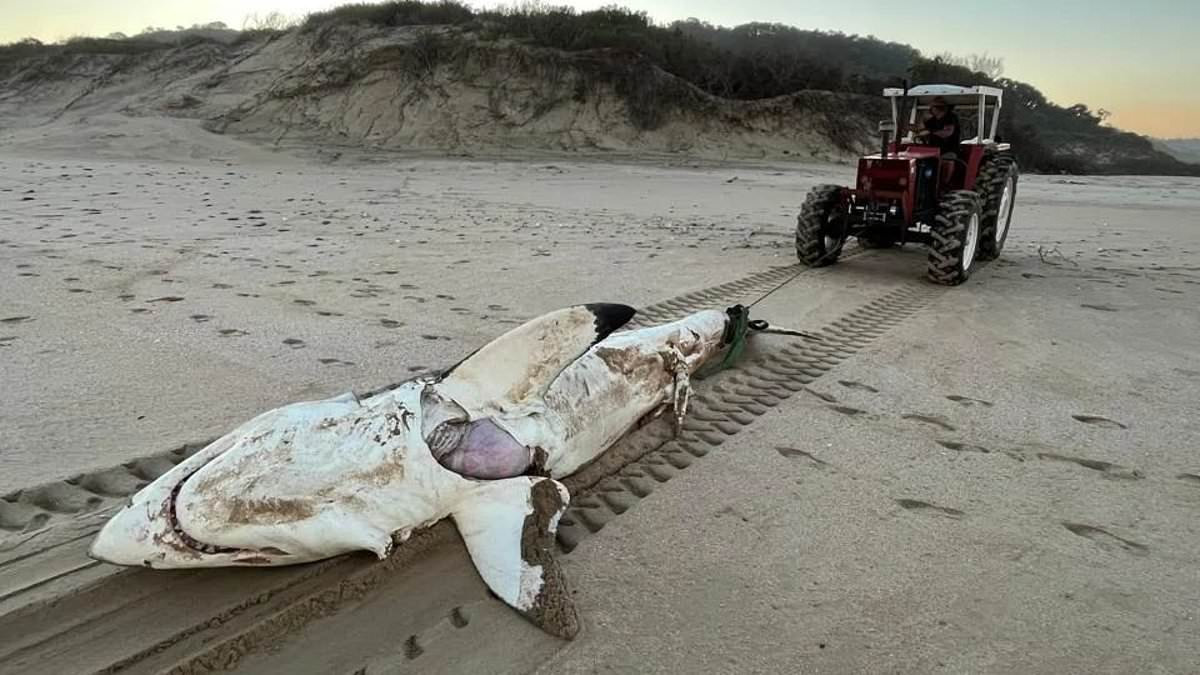An enormous great white shark that washed up on the South African coast had just scarfed down a dolphin before a larger predator got them both.
Biologist Alison Towner shared photos to social media following the necropsy of the 15-foot-long shark, confirming that ‘killer whale predation’ was the cause of its demise.
Scientists were called to the scene after a resident stumbled upon the mangled carcass at the Nyara River Mouth on May 28.
The following day, veterinarians finished an examination of its corpse and recovered a common dolphin from its stomach that was neatly severed into four pieces.
The most telltale signs of an orca attack were toothmarks on the creature’s head, plus an even more pressing clue – a missing liver.

Scientists have documented an odd phenomenon where orcas kill sharks and pull their livers out through a clean incision in the shoulder

After a carcass was discovered on May 28, scientists determined that the shark had been killed by an orca due to toothmarks on its head and an even more telling clue – a missing liver

The finding marked the 14th confirmed case of white shark predation by killer whales in South Africa since 2015 (pictured: a carcass washes up in Mossel Bay, South Africa in 2022)
The ‘significant’ discovery marked the 14th confirmed case of white shark predation by killer whales in South Africa since 2015.
Scientists believe orcas are targeting sharks in the area for their livers, and a growing body of evidence suggests that the behavior is becoming increasingly common.
Five great whites washed up in Gansbaai without their livers in 2017. It wasn’t until May 2022 that drone footage captured two male orcas hunting the sharks and removing the vital organs with ‘surgical precision.’
The killer whales were dubbed Port and Starboard for their dorsal fins, which bend left and right, respectively.
Last February, 19 seven gill shark carcasses washed up near Towner’s home without their livers, leading her to instantly suspect the pair.

Biologist Alison Towner has been studying the bizarre hunting behavior for years
Read More
Sharks have a flight response: Great Whites avoid hunting grounds around South Africa for seven weeks after a group was viciously attacked and killed by orcas

Her suspicions were confirmed that June, when Starboard was spotted hunting down a great white near Seal Island, killing it in under two minutes and surfacing near a tourist boat with its liver in his mouth.
Orcas are highly social and often work together to snag large prey like sea lions, whales and sharks.
However, the increasing evidence of solitary kills, such as in Starboard’s case, sheds light on hunting capabilities that were previously unknown to researchers.
In most cases, the rest of the sharks’ organs were left intact while their livers were pulled out through a clean incision in the shoulder.
One theory is that orcas have developed the behavior to protect their teeth from sharks’ coarse skin, as the liver alone is enough to provide a full meal.
The hunting behavior has been the subject of several research papers – and while it fascinates scientists, they also recognize its grim implications for the marine ecosystem.
As the population of great whites and sevengills, both apex predators, is continuously depleted or forced to migrate, this may have a dramatic effect across the South African coast.
One possibility is that prey species will experience a surge in numbers, upsetting the delicate natural balance.
There is also a chance of a phenomenon known as mesopredator release, in which populations of medium-sized predators rapidly increase once larger carnivores disappear.

The 15-foot-long carcass washed up at the Nyara River Mouth, revealing that the animal had eaten a dolphin shortly before its demise

A pair of male orcas, dubbed Port and Starboard for their left- and right-leaning dorsal fins, have been documented engaging in the strange hunting behavior
Towner and other experts continue to monitor orcas’ hunting behaviors and strive to better understand them.
Starboard’s solitary takedown of the great white was showcased in an article published in the African Journal of Marine Science in March.
Whale conservation expert Simon Elwen noted that killer whales ‘can rapidly learn new hunting techniques on their own or from others.’
Towner deemed the findings ‘groundbreaking.’
‘The astonishing predation, off the coast of Mossel Bay, South Africa, represents unprecedented behavior underscoring the exceptional proficiency of the killer whale,’ she said.
